| Please access the following URL if you want to secure using SSL. All pages in the site will be secure pages. |
| https://secure02.blue.shared-server.net/www.fish-food.co.jp/message english 9.2019.html |
Welcome to FISH FOOD TIMES
Sep. 2019 issue No.189


Hanasaki crab with boiled
Now is the season, "Crab Festival" on September 1 in Nemuro
On September 1st (Sunday), the update date for this month's FISH FOOD TIMES, the Crab Festival is being held in Nemuro City, Hokkaido.
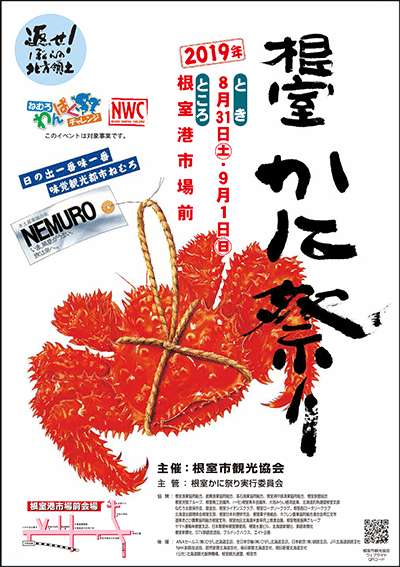
This crab festival is an event in which Hanamasaki Port in Nemuro City appeals to Hanasaki Crab, which boasts the highest landing height in Japan. In Japan, Hanasaki crabs are mostly caught in the waters near Cape Nosappu on the Nemuro Peninsula. Hanasaki crabs have a small catch, and like snow crab and king crab, it is not a crab that can be purchased easily and somewhere in the country. It is necessary to find out which store in the country sells it.

In the above image, the author took a picture of the Hanasaki crabs sold in Nemuro, Hokkaido in November 2017, but these are probably boiled and frozen from the Hanasaki crabs caught in summer. Because Nemuro is only allowed to fish for 3 months from July to September every year, it can be assumed that the landed Hanasaki crab will continue to be sold little by little until the next season.
As shown in this image, Hanasaki Crab is sold for 3,500 to 4,000 yen. Although it is such an expensive Hanasaki crab, it is not a crab but a hermit crab. The reason for this is that the crab has four legs on the left and right, excluding the part with the claws, but the Hanasaki crab has only three legs, so it is classified as a kind of hermit crab. As for the classification, it belongs to the king crab family king crab genus. It is a relative of the king crab and is smaller than the king crab, has short legs and is thick, and has many thorns on the surface.
Hanasaki Crab seems to have an image that it originally has a red color like a red flower from the name that the flower blooms, but it is the state after boiling, the color of the raw state Is the following image.
�@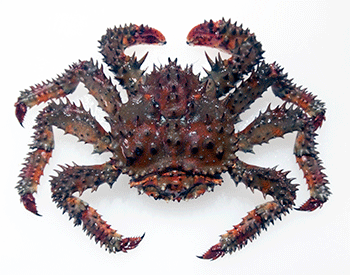 �@
�@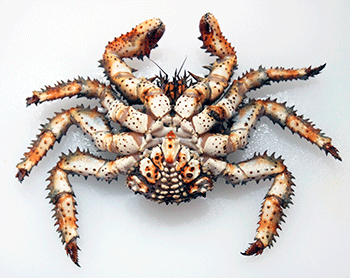
I didn't know if I was male or female when I bought this image. I researched how to identify them, but I couldn't find the material after all. The method for distinguishing males and females of ordinary crabs can be determined to be female if the part called fundoshi portion is wide, such as a blue crab, and male if it is narrow. However, all of the purchased Hanasaki crab loincloth had the same shape.
Later, it was decided that the Hanasaki Crab was male. This is because it has been found that the Hanasaki Crab, which is the target of fishing, has an arrangement that only the male whose shell length has grown to more than 8 cm. In the past, Hanasaki crab was caught about 1,000 tons per year, but it is now one-tenth, less than 100 tons. In order to prevent stock loss due to overfishing, the current catch is finally maintained by using methods such as prohibition of fishing for 3 years and development of artificial breeding seedlings. It seems to be a bitter plan to keep the descendants of Hanasaki Crab.
Commercialization of Hanasaki Crab with boiled in salt water
By the end of August, I was lucky enough to get the raw Hanasaki crab and decided to commercialize it. Not only Hanasaki crabs, but crabs generally rot immediately when sold in the raw state, so it is common to sell them in a heated state such as boil unless they are live crabs. So this was also in salt water.
| Hanasaki Crab with boiling in salt water work process | |
 |
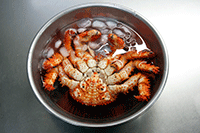 |
| �P�CAdd salt to boiling water to a salinity of 3%. | 6�AAfter boiled Hnasaki crab in salt water is finished, put it in ice water to remove the rough heat. The edible part inside the shell is easily removed. |
 |
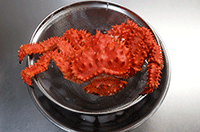 |
| �Q�Cn order to leave as much umami ingredients as possible, put the shell down and put it in boiling water. | 7�CTo remove the water, drain the water for a minute. |
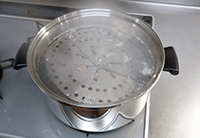 |
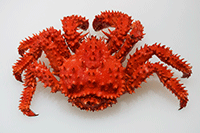 |
| �R�CIf you boil Hanasaki Crab, it will come up, so put a drop lid to prevent it from floating. | 8�CHanasaki Crab boiled in salt water is complete. |
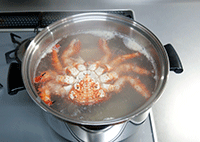 |
 |
| �S�CPick up lye that sometimes floats and boil around 15 to 20 minutes. | 9�CIt is better to show the shell when commercializing the tray, but a drip comes out of the shell and escapes the umami ingredients. |
 |
 |
5�AAfter hanasaki crab boiled in salt water finishes, the surface turns red. |
10�CIn order not to miss the umami ingredients with the drip, turn it over and commercialize. |
In this way, the boiled in salt water boiled in salt water has been commercialized, but there are people who do not know how to eat it as it is, or who feel that the work ahead is troublesome. Since the processing level is low and it is difficult to sell just by boiling as in the above image, I decided to make further efforts to commercialize the product to add value.
| The work process to serve hanasaki crab as a figure with boiled in salt water | |
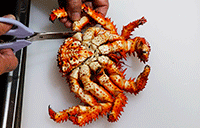 |
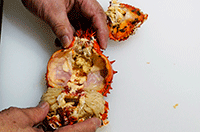 |
| 1�CWith the shell down, cut the second joint of the third leg at the left end with cooking scissors. | �U�CWith the outside of the shell facing down, take care not to flow out the umami ingredients and separate the shoulder meat part. |
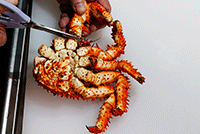 |
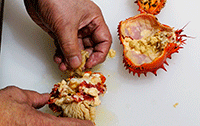 |
| �Q�CCut to the crab claws in order from the bottom and cut to the left crab claws parts. | �V�CRemove gills called gani inside the shoulder meat with fingers. |
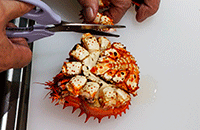 |
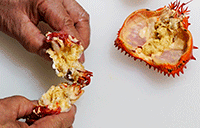 |
| �R�CTurn right from the right crab claw and cut all the way to the right third leg. | �W�CTo make it easier to eat, the shoulder meat is cut using cooking scissors and cut in half. |
 |
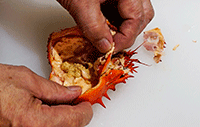 |
| �S�CNext, open the fundoshi part and cut off the part connected to the shoulder meat. | �X�CRemove the membrane covering the inside of the shell with fingers. |
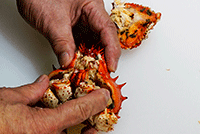 |
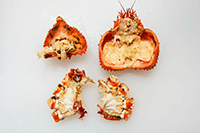 |
| �T�COpen the shell and shoulders meat. | �P�O�CShell, shoulder meat half, fundoshi. |
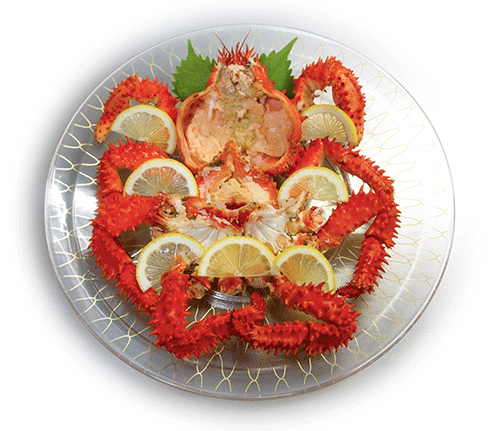 |
|
| �@ Hanasaki crab as a figure with boiled in salt water made with emphasis on appearance. | |
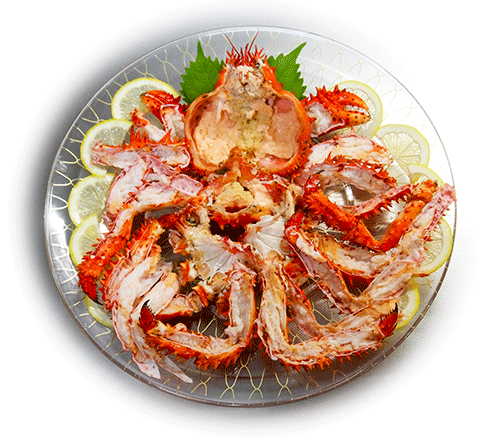 |
|
| �A Although it does not look good, hanasaki crab is served as a figure with boiled in salt water,to make it easier to eat by cutting on legs and crab claws with cooking scissors. | |
The raw Hanasaki crabs were commercialized into boiled in salt water, and as the next work, the legs were cut off and the shoulder meat was disassembled into the shape of �@ to increase the commercial value. Next, the legs were cut in half with cooking scissors to make it easier to eat, and the added value was further increased. Now customers who have purchased �A Hanasaki Crab will be able to eat immediately, but �A looks a little worse than �@, but I think that customers can appreciate the ease of eating.
However, in order to purchase one Hanasaki crab, you must prepare for a higher price than 3,000 yen or 4,000 yen. It's hard to buy at normal times, and they aren't so easy to buy unless they are anything special. For example, on the Internet mail order site, the boiled products of Hanasaki Crab that are about 800g in size and remain in their original form are so expensive that they are sold for 5,000 to 7,000 yen.
Hanasaki crabs are limited in the area where they are caught, and the amount of fish caught is less than 100 tons per year, so the distribution volume throughout the country is also limited, so it is often treated as a regional limited product in the eastern Hokkaido area. On the other hand, hair queen crab, which is the main production area in Hokkaido, has become extremely expensive this year, and is making noise in related industries.
Hair queen crab unfishing and price rise.
The image below shows the Hanasaki crab sold in Nemuro, Hokkaido in November 2017, introduced near the top of the page. Next to it, hair queen crab was sold at a higher price than Hanasaki Crab.
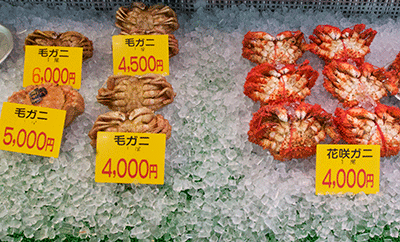
This image is two years ago, but this year's hair queen crab market seems to be higher, and the average wholesale price at Toyosu Fish Market as of July is as shown in the table below.
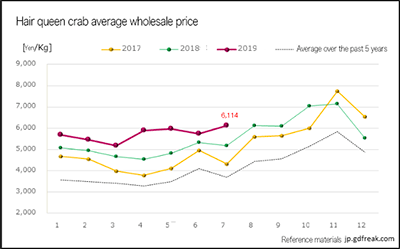
This year, the Sea of Okhotsk became severely unfished from spring to summer, the season of hair queen crab. It is almost certain that the catch will be halved compared to last year without waiting for the last fishing in August, and the market price has soared due to this unfishing.
As for the hair queen crab, it is usual that the market price goes up toward the demand season of the year-end sales season, but if it is more than 6,000 yen per kg at this time, the demand for hair queen crab will stagnate in the future due to so-called "high price fatigue" ,there is a view that the future hair queen crab market may be somewhat calm.
The price of most crabs, including not only hair queen crab but also king crab and snow crab, has continued to rise over the last ten years. However, this year, questions are starting to come about how long the bullish price formation of crabs will continue. This is because there are some uncertainties about how the global economic situation will become in the future due to the impact of the US-China economic friction and the deterioration of Japan-Korea relations. Especially in Japan, there is a tax reform that will affect all the citizens in October, with an increase in the consumption tax rate, and what changes will this have in the Japanese economy going forward? It is unclear whether crab species, which are representatives of luxury luxury foods, can continue to form the same climbing price in the negative economic situation.
High-grade food crab is a symbol of luxury
Crab products are not only edible crabs, snow crab, hairy crabs, hanasaki crabs, crabs, but also less well known shanghai queen crab, asahi queen crab, rock crab etc. It is expensive and the crab ingredient is a symbol of luxury.
For example, in the case of a foreign country, the image below shows the copper river fishery market in Shanghai in the lower left and the Jagalchi fish market in Busan in the lower right. Crabs such as king crab and snow crab were mostly put in live fish tanks and sold as live crabs.
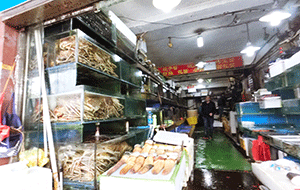 �@
�@
These images show that Shanghai was three years ago and Busan was four years ago, and the economy was steady in both countries. In particular, China had momentum to drop flying birds. It was a time when no one would have thought about the Chinese economy's changes due to economic friction between the US and China. At that time, most of the live crabs from Russia were over to China and South Korea, and Japan was suffering from the problem that it was sold out and only a few were imported from Russia.
And if you look at the current international situation, you can understand it, but the question arises whether China and South Korea will be able to maintain the economic momentum of three or four years ago. It is clear that President Trump is trying to constrain China's traditional economic development methods by means of tariffs. As long as Trump continues to be president, China will no doubt be confused by its conservative thinking.
In other words, China's economic development method, which has been established by exporting various products that have been produced with the cheap labor force of the country as a weapon, can be shaken from the ground up. The Chinese economy, which has already undergone modulation, may be shaken even more. It can also lead to a decline in China's purchasing power, which has influenced global economic trends, and it can be considered that it will also affect the consumption of crabs that are a symbol of luxury goods.
Various crab products are basically the same in other countries as rich products that rich people in economically rich countries eat with the power of money. Even in Japan, there is an idea that you want to eat gorgeous crabs only once a year on New Year's Day, so there is a unique phenomenon in the supermarket where you can sell 80% of the annual sales of crabs only in the year-end sales season in December.
For the past 10 years, the market for crabs has continued to rise. As a result of the steady economic development of China with a large population, the wealthy people who became rich also increased, and it is thought that there is an aspect that the purchasing power of such wealthy people has pushed up the price of luxury goods such as crabs.
However, as mentioned above, there are still unclear parts of the impact of the US-China economic friction that has occurred since last year, but there is no doubt that the Chinese economy will change momentum as before. And I am interested in how the market trends for crab products, which is a symbol of luxury.
This month's issue refers to the theme of the Hanasaki Crab, and the movement of the global economy that is revealed by the market trend of crab products. This is because the market price of crab products is greatly influenced by unfishing and rich fishing, but we also wanted to note that there is an aspect that the balance between demand and supply due to economic trends also has a significant impact.
I think that it is not only oneself to want to be able to eat not only Hanasaki crabs, but also king crab, snow crab and hair queen crab several times a year, not just the New Year.
| Please access the following URL if you want to secure using SSL. All pages in the site will be secure pages. |
| https://secure02.blue.shared-server.net/www.fish-food.co.jp/message english 9.2019.html |
An opinion and the communication are to iinfo@fish food times
Date of updating 1 Sep. 2019
